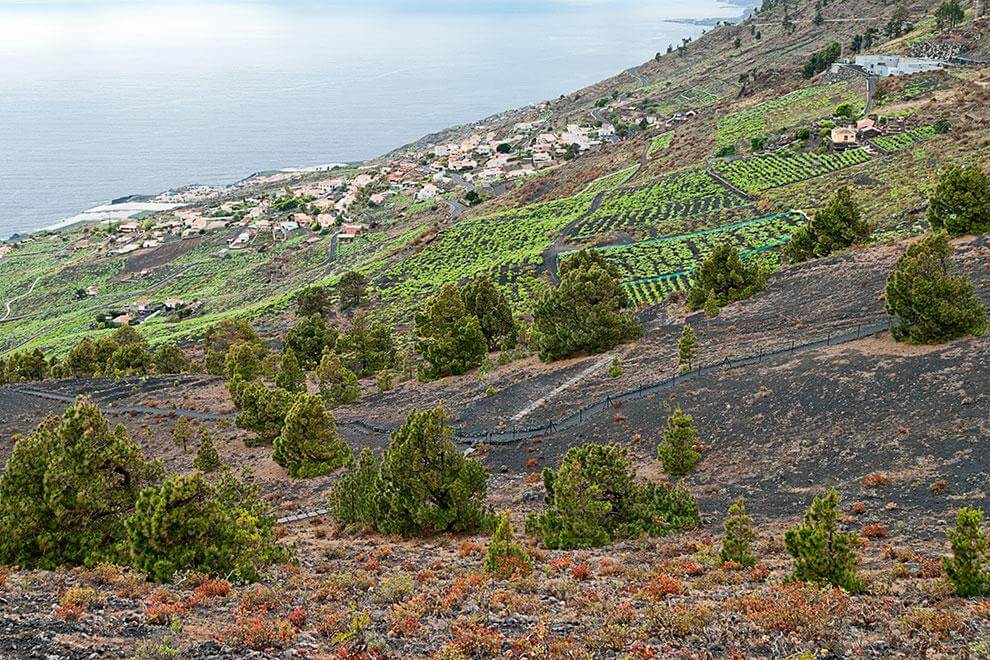Visiting La Palma means entering a universe of flavors with as many contrasts as the island's own orography. From the sweet of its desserts, an inheritance of the production of sugar cane, to the saltiness of its impressive artisanal salt mines, passing through its iconic Canarian pine wines, Isla Bonita is a gastronomic oasis that has its own seal of quality: Taste La Palma.
Landscapes with Flavor and Tradition
The varied and rich cuisine of La Palma is intrinsically linked to its landscape and tradition. Endowed with a privileged climate, on Isla Bonita there are vast avocado and banana plantations, with blooming almond trees or volcanic areas covered with vines. A show of color that is completed with the immaculate white of the Fuencaliente Salt Flats, and the farms of the goats native to the area.
Craft production is another hallmark of Palmerian cuisine that has preserved the intense flavors of the past to this day thanks to ancestral techniques, such as the one used to make its cheeses. Also the wines of La Palma are the result of a unique form of fermentation, in Canarian pine barrels, which makes any bottle a delight. The vineyards in La Palma are located both on slopes with steep slopes and on land covered with volcanic ash (picón).









The Palmerian Menu
But what should we ask for in La Palma when we sit at the table? Although the offer is very varied, typical Palmerian food would start with some chicharrones with their touch of gofio, or natural cheese or roast with mojo picón. Then, and for lovers of the spoon, chickpeas, mince soup or wheat stew.
Once on the main course, you can choose between meat or fish, two ingredients to achieve the highest quality on this island, and which can be tasted in recipes as varied as goat meat in sauce, grilled pork, rabbit, goat or ribs with mojo and pineapples (cobs). As in the entire archipelago, fish is a star dish. That's why there's nothing like tasting a dish of stewed vieja, fried alfonsiño or grilled bigeye (bluefin tuna), all accompanied by crumpled potatoes with mojo (red for meat, green for fish). Any meal must be watered by a good Palmerian wine, with a designation of origin, and completed with some of the exquisite Palm desserts.
The Sweetest Island
Pastry is undoubtedly the greatest treasure of Palmerian cuisine. Not in vain was the island for centuries an epicenter of sugar cane cultivation. The successive crises in this sector forced the Palmerians to transform the surpluses into sweets, jams, preserves or biscuits. Many of these recipes have survived and continue to sweeten Palmerian palates.
It is therefore essential to try the rapadura, conically shaped and made with cane honey, gofio, sugar, cinnamon, almond and lemon. The Bienmesabe, based on sugar, almonds, egg yolks, cakes, cinnamon, lemon rind or anise. Also the almond cheese or Prince Albert, with chocolate, almonds and sponge cake will delight the visitor. A special case are marquesotes, wheat flour cakes, eggs and sugar cut into a rhombus shape, which in the 19th century reached the tables of the Vatican. Since then, these sweets have been called pioneers.

The Wines that Conquered Shakespeare
Finally, Palmerian wines are an exquisiteness worthy of Shakespeare himself, who in some of his works refers to the variety of Malvasia, grown on the island. These wines, made naturally, stand out both for their golden color and for their soft sweetness, as well as for their aroma and exuberance.
Special mention should be made of Canarian pine wines, so called because they are aged in wooden barrels extracted from Canarian pine. Its exclusive form of fermentation, as well as the peculiarities of the vine, which comes from volcanic soil, and the fact that many of its varieties predate the phylloxera plague, make La Palma wines a delicacy worthy of the most exclusive palates.



Museums, Parties, Crafts and Flavored Souvenirs
But Palmerian cuisine is not limited only to the table, but also permeates the entire culture that surrounds the island. From the festivities themselves, some in honor of the Palmerian flavor (La Vendimia, in Fuencaliente or the Almond Tree in Flower, in Puntagorda) in which it is typical to consume wine, sugared almonds, sweets, gofio and other characteristic products of the island to the landscapes, impregnated with gastronomic elements with their bananas, vines... Palmerian flavor can also be encountered in some of the museums that are spread around the island, such as the Banana Museum, the Gofio Museum or the House of Wine.
For visitors who like to enjoy ingredients, on the island there are numerous farmers' markets where farmers, ranchers, winemakers, cheesemakers and artisans offer their best products. Finally, remember that Palmerian cuisine is a good idea to take as a souvenir of the island or as a gift. Thus any of the crafts made in relation to the food such as the baskets to load the grapes; the ones used to make the cheese or the hand-embroidered tablecloths to dress the beautiful table to enjoy a succulent Palmerian menu.
















